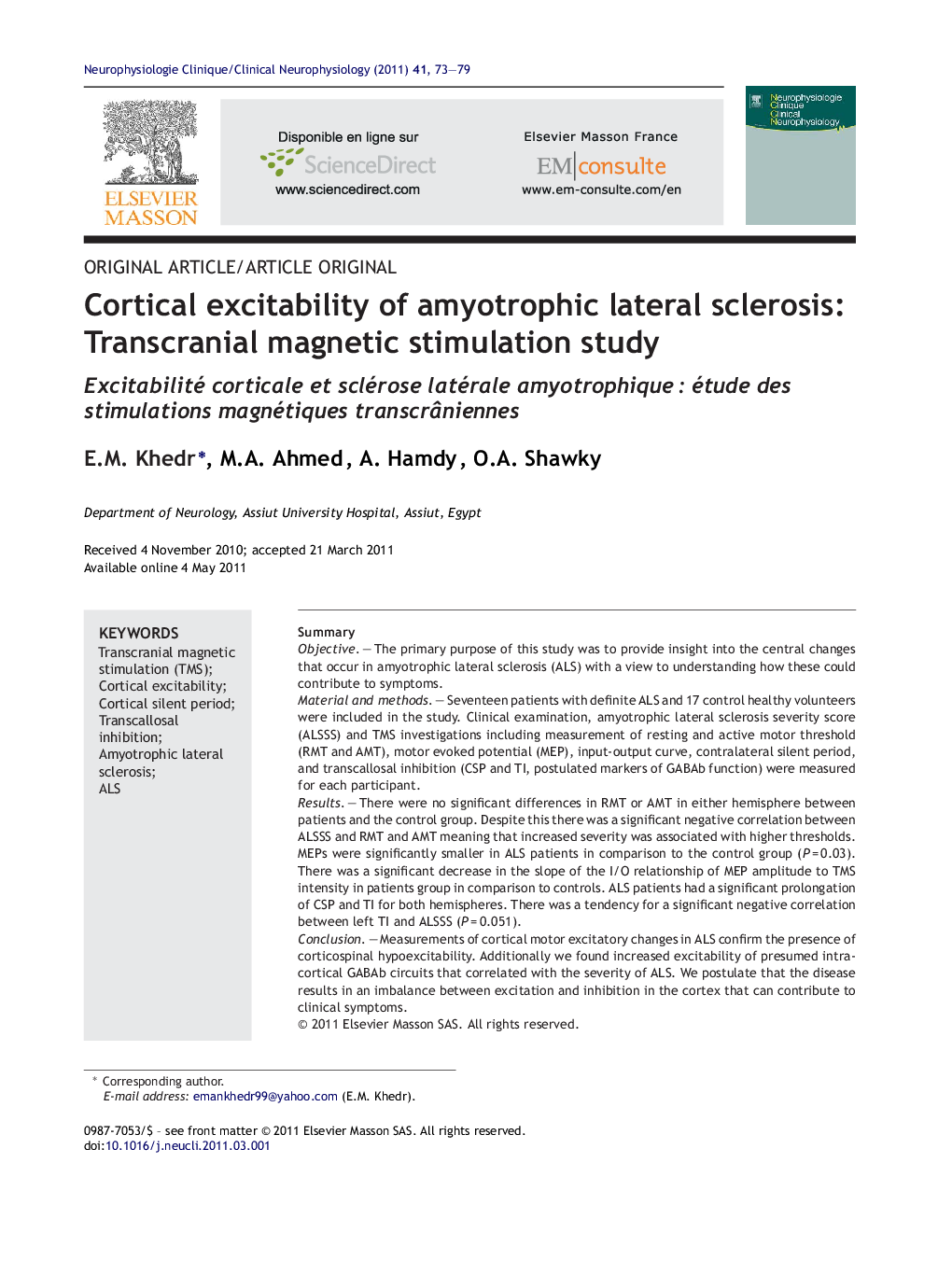| Article ID | Journal | Published Year | Pages | File Type |
|---|---|---|---|---|
| 3083013 | Neurophysiologie Clinique/Clinical Neurophysiology | 2011 | 7 Pages |
SummaryObjectiveThe primary purpose of this study was to provide insight into the central changes that occur in amyotrophic lateral sclerosis (ALS) with a view to understanding how these could contribute to symptoms.Material and methodsSeventeen patients with definite ALS and 17 control healthy volunteers were included in the study. Clinical examination, amyotrophic lateral sclerosis severity score (ALSSS) and TMS investigations including measurement of resting and active motor threshold (RMT and AMT), motor evoked potential (MEP), input-output curve, contralateral silent period, and transcallosal inhibition (CSP and TI, postulated markers of GABAb function) were measured for each participant.ResultsThere were no significant differences in RMT or AMT in either hemisphere between patients and the control group. Despite this there was a significant negative correlation between ALSSS and RMT and AMT meaning that increased severity was associated with higher thresholds. MEPs were significantly smaller in ALS patients in comparison to the control group (P = 0.03). There was a significant decrease in the slope of the I/O relationship of MEP amplitude to TMS intensity in patients group in comparison to controls. ALS patients had a significant prolongation of CSP and TI for both hemispheres. There was a tendency for a significant negative correlation between left TI and ALSSS (P = 0.051).ConclusionMeasurements of cortical motor excitatory changes in ALS confirm the presence of corticospinal hypoexcitability. Additionally we found increased excitability of presumed intracortical GABAb circuits that correlated with the severity of ALS. We postulate that the disease results in an imbalance between excitation and inhibition in the cortex that can contribute to clinical symptoms.
RésuméBut de l’étudeÉtudier les dysfonctionnements nerveux centraux associés à la SLA et examiner dans quelle mesure ceux-ci peuvent contribuer à ses symptômes.Patient et méthodesNous avons inclus 17 patients porteurs de SLA et 17 contrôles. Pour chaque sujet, nous avons réalisé : un examen clinique, la mesure du score de sévérité de la SLA (ALSSS) et des stimulations magnétiques transcrânienne avec les mesures suivantes : seuil moteur au repos (SMR) et sous-activation (SMA), potentiels évoqués moteurs (PEM), courbes de relations entrées-sortie (CRES), période de silence controlatéral et inhibition transcalleuse (ITC et IT, constituant des marqueurs probables de la transmission GABAb).RésultatsLes SMR et SMA ne différaient significativement dans aucun hémisphère entre les patients et les contrôles. Néanmoins, nous avons retrouvé une corrélation négative significative entre l’ALSSS et les SMR et SMA, un score de sévérité accrue étant associé à des seuils plus élevés. L’amplitude des PEM était significativement plus faible chez les patients que les contrôles. La pente de la relation amplitude du PEM et intensité de stimulation était significativement plus faible chez les patients. Une prolongation de l’ITC et de l’IT fut retrouvée au niveau des deux hémisphères chez les patients porteurs de SLA avec une tendance à une corrélation négative significative entre l’ALSSS et l’IT sur l’hémisphère gauche (p = 0,051).ConclusionLa mesure des modifications de l’excitabilité du cortex moteur confirme l’existence d’une hypoexcitabilité corticospinale dans la SLA. Nous avons également retrouvé une excitabilité accrue de circuits intracorticaux GABAb, corrélée à la sévérité de la maladie. Nous postulons qu’un déséquilibre entre l’excitation et l’inhibition intracorticale pourrait contribuer à la symptomatologie clinique.
